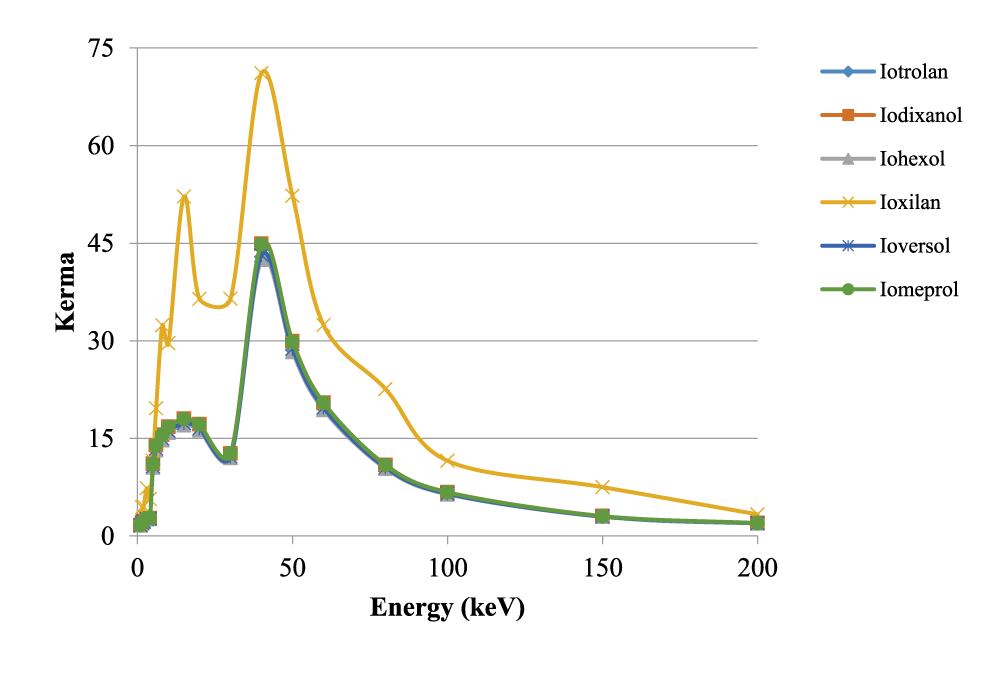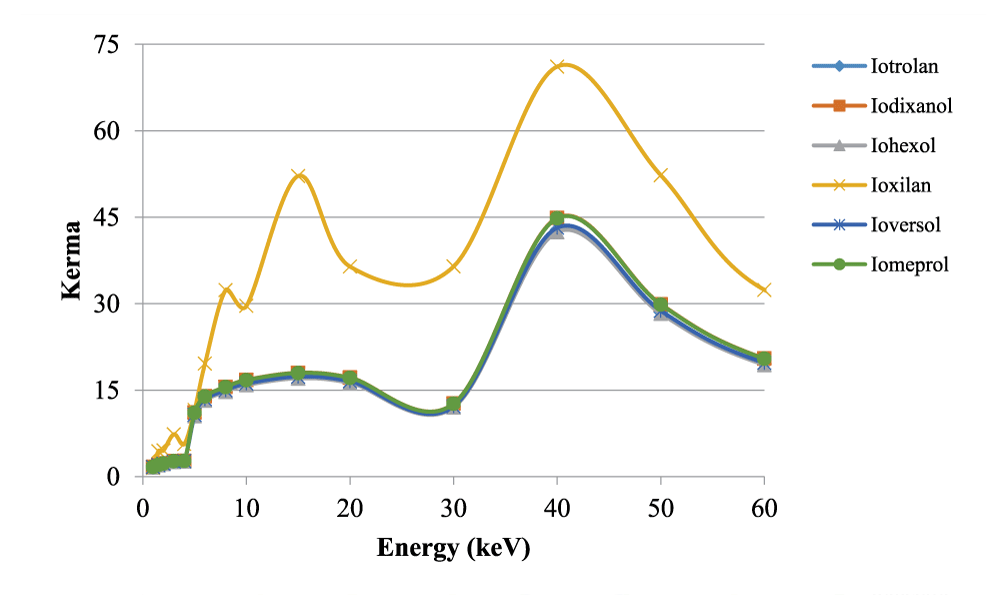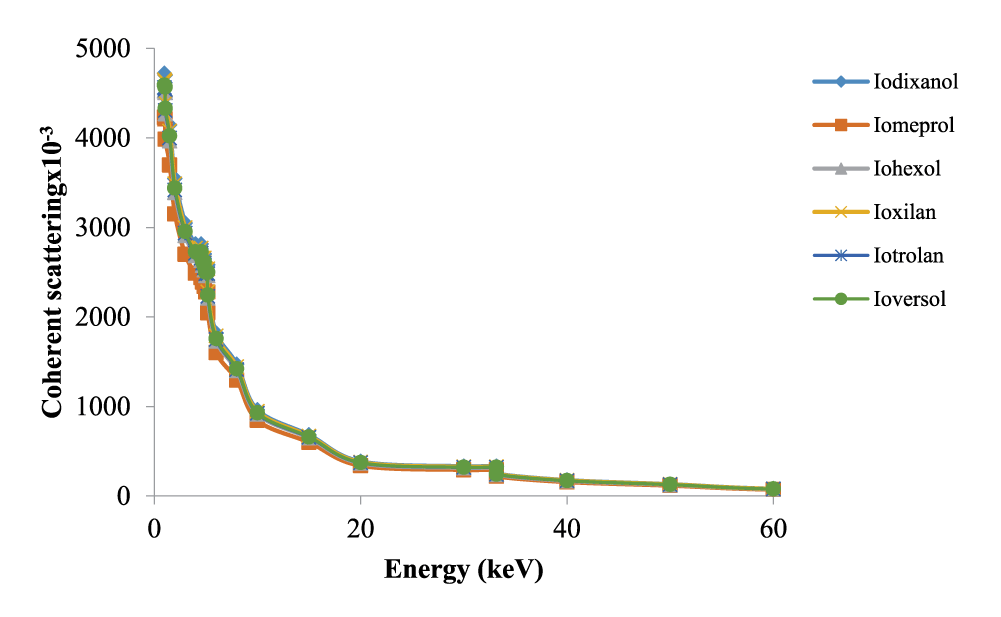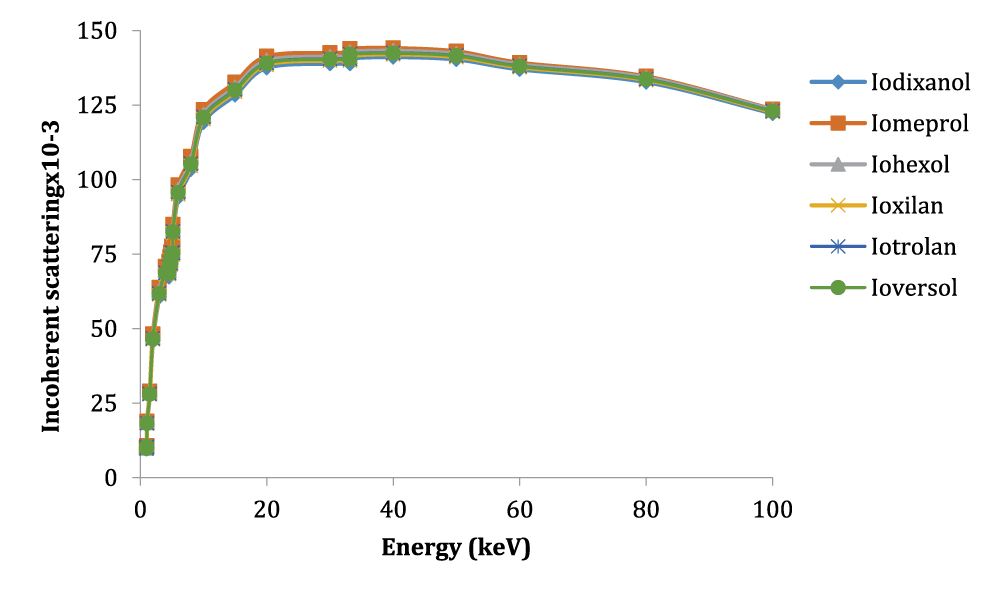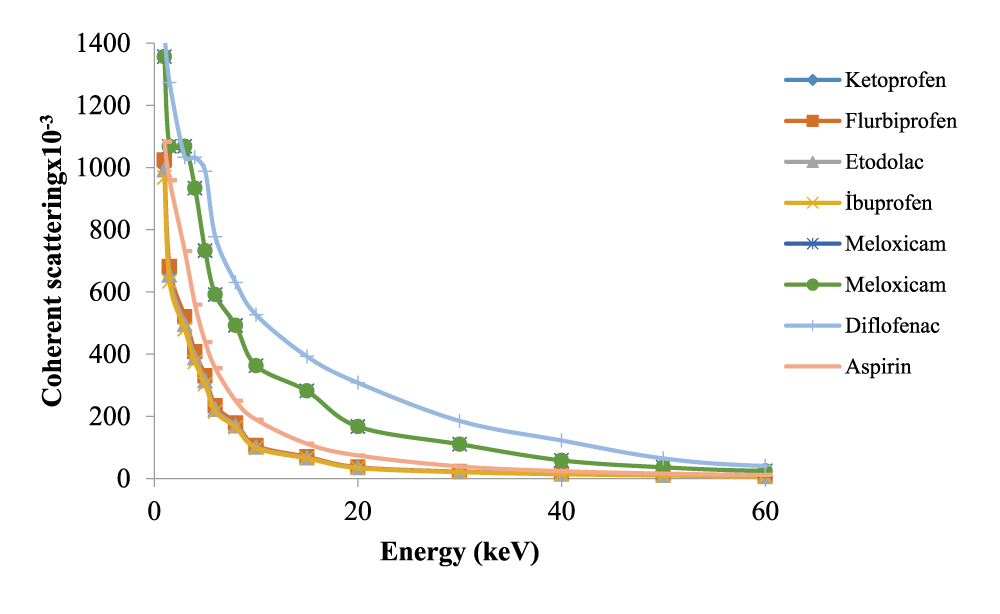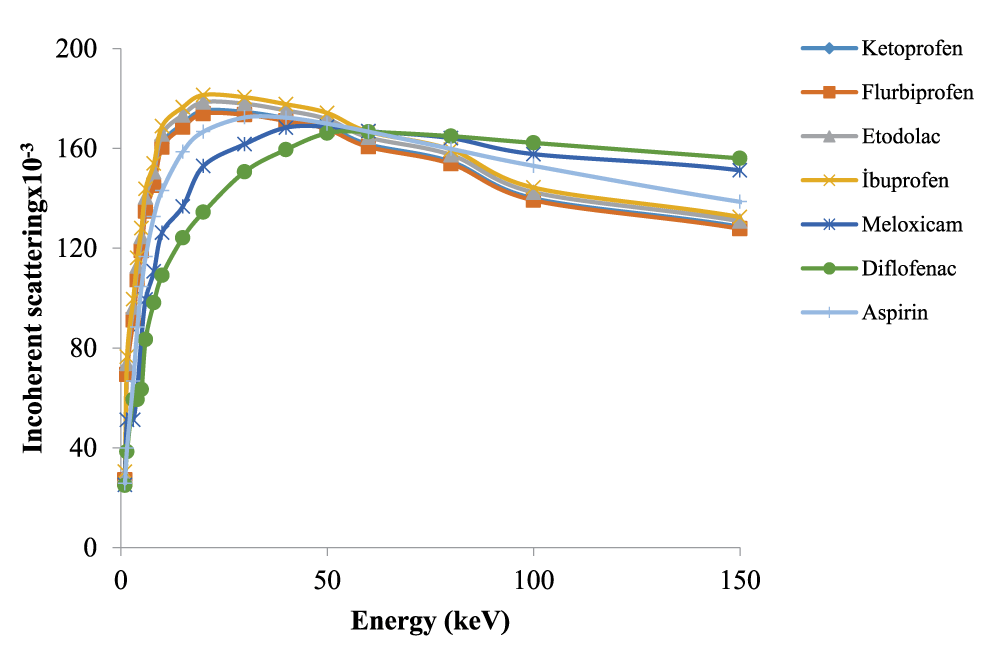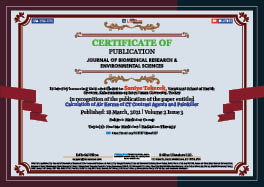> Medicine Group. 2021 Mar 18;2(3):178-184. doi: 10.37871/jbres1207.
Calculation of Air Kerma of CT Contrast Agents and Painkiller
Saniye Tekerek*
- CT contrast agents
- Mass attenuation coefficient
- Kerma
Abstract
In this study have investigated the mass attenuation coefficient and air Kerma of some CT contrast agents and painkiller. The mass attenuation coefficient and air Kerma of Iotrolan, Iodixanol, Iohexol, Ioxilan, Ioversol, Iomeprol, Ketoprofen, Flurbiprofen, Etodolac, İbuprofen, Meloxicam, Diflofenac and Aspirin have been calculated by using WinXCom in the energy range from 1 keV to 1000 keV. The current study would be useful to develop new shielding materials in radiation application fields.
Introductıon
Investigation of radiation effects on biologically important molecules is very important research in medicine and radiation biophysics. The study of radiation interactions with sample and the data on the attenuation of X and gamma-rays in biologically shielding and dosimetric materials assumed great significance by virtue of their various applications [1].
The results show that MAC is a useful physical quantity to determine the Kerma for compounds. Values of MAC depend on the chemical content of the investigated compounds. The photon interaction parameters were investigated to verify the applicability of the mixture rule over different samples in various energy.
The kerma vary markedly from sample to sample, with the highest values usually being for the lower atom masses. Gamma and X-rays are extensively used for diagnostics in nuclear medicine, CT scanning, gamma knife surgery, mammography, radiotherapy, radiology. As a consequence, various human tissues and biological material are exposed to high radiation. It is very important to know that how these material can be affected when exposed radiation [2]. Kerma is the sum of the Initial kinetic energies of all charged particles liberated by indirectly Ionizing particles in a small volume element of a specified material divided by the mass of material in that volume element [3].
The Mass Attenuation Coefficient (MAC) is a fundamental photon interaction property for calculation of shielding properties in biological materials [4], human body organs [5] and tissue substitutes [6] were investigated by different researchers. Some researchers studied Kerma values of various fatty acids and some carbohydrates [7], some vitamins in the energy range of 356.61-661.66-1250 and 1408.01 keV [8] photon kerma parameters for human body organs [4].
Our present investigation of MAC and Kerma of some contrast agents, and painkiller compounds for total radiation interaction processes should be useful to scientists. It is needed to know abouth the mass attenuation coefficient in order to calculate air Kerma of the compounds.
In this study air Kerma values was calculated for some medically important compounds. The MAC and Kerma are informed us abouth the caracteristic properties of some medical compounds. The aim of present investigation is to study the behavior of these compounds absorption parameters i.e. MAC (μ/ρ) and Kerma.
In medical imaging field, the knowledge about how the high energy beam interacts with CT agent compounds leads to progress the clinical diagnosis by the CT scan. The medical imaging field information about air Kerma the scattering radiation interacts in with medium can be guide progress the this field [5,9,10]. However, although the CT agents are part of imaging and dosimetre information such studies for Kerma values of this materials are less in literature. Consequently, investigation of the radiation interaction with these CT agents and painkiller have is to be reached. In the present work, the CT contrast agents and painkiller have been calculated for the first time in terms of the air Kerma.
Materıals and Methods
The computed tomography investigation, a photon is sorption as it passes through a human body organ by CT agents.
This study was undertaken to obtain information on MAC and Kerma for some medical compounds. Values of MAC depend on the chemical content of the investigated compounds. This present parameters were investigated to verify the practicable of the mixture rule over different medical compounds in constant energy. MAC and air Kerma at high photon energy were investigated since compounds have grand scale application in the technology of medical and nuclear field.
The mass attenuation coefficients for any chemical compound are estimated using the elemental values the Bragg’s-rule formula [11].
Total MAC is calculated by equation [12].
where (I) attenuation, (I0) unattenuation intensity, ρ (gr/cm3) is the density of the compounds.
Kerma is the ratio of air mass attenuation coefficient and compound mass attenuation coefficient to each other. The Kerma value of a compound relative to air was calculated using Formula 6:
where; is compound mass attenuation coefficient and is air mass attenuation coefficient. The MAC is the amount of initial beam energy transferred to kinetic energy charged particules by radiation interaction. Energy mass attenuation coefficient related to air mass attenuation coefficient through the following relation Formula;
where is mass attenuation energy transferent coefficient
is mass attenuation energy absorption coefficient (cm2/g)
: bremstrahlung fraction
For low atomic number samples and beam energies below 1 MeV, the bremsstrahlung fraction g≈0; (μen/ρ) ≈ (μtr/ρ) [13].
Results and Discussion
In this study, mass attenuation coefficients and air Kerma of CT agents and painkiller compounds have been investigated in the energy range between 1 keV and 1000 keV. The values of the MAC have been calculated by the WinXCom data programme. The values of air Kerma were calculated by using mass attenuation coefficient for each CT contrast agent and painkiller.
The mass attenuation coefficient was increased with the increasing iodine ratio in the CT contrast agents compounds as shown in table 1, this increment attributes to the high molecular weight of iodine compounds. Results shows that the fractional weight increases linearly with increasing I content.
| Table 1: MAC of CT contrast agents compounds. | ||||||
| Energy keV |
Mass attenuation coefficient (cm2/gr) |
|||||
| Iotrolan | Iodixanol | Iohexol | Ioxilan | Ioversol | Iomeprol | |
| 1 | 5847 | 5958 | 5806 | 5455 | 5874 | 5972 |
| 1.5 | 2357 | 2413 | 2339 | 5208 | 2369 | 2418 |
| 2 | 1165 | 1196 | 1156 | 2386 | 1172 | 1198 |
| 3 | 418.1 | 430.5 | 414.7 | 1181 | 420.5 | 430.9 |
| 4 | 198.9 | 205.2 | 197.3 | 424.6 | 200.1 | 205.4 |
| 5 | 410.1 | 428.4 | 406.2 | 446.0 | 413.0 | 427.6 |
| 6 | 298.0 | 311.6 | 295.1 | 438.4 | 300.1 | 311.0 |
| 8 | 140.5 | 146.9 | 139.1 | 305.6 | 141.5 | 146.7 |
| 10 | 78.04 | 81.65 | 77.30 | 144.1 | 78.60 | 81.48 |
| 15 | 26.43 | 27.650 | 26.170 | 80.070 | 26.620 | 27.59 |
| 20 | 12.23 | 12.790 | 12.110 | 27.120 | 12.310 | 12.76 |
| 30 | 4.172 | 4.360 | 4.134 | 12.540 | 4.201 | 4.350 |
| 40 | 10.47 | 10.970 | 10.370 | 17.380 | 10.550 | 10.95 |
| 50 | 5.879 | 6.157 | 5.824 | 10.760 | 5.921 | 6.142 |
| 60 | 3.648 | 3.818 | 3.615 | 6.037 | 3.674 | 3.809 |
| 80 | 1.735 | 1.811 | 1.720 | 3.745 | 1.747 | 1.807 |
| 100 | 0.995 | 1.036 | 0.987 | 1.779 | 1.001 | 1.034 |
| 150 | 0.403 | 0.415 | 0.400 | 1.018 | 0.405 | 0.415 |
| 200 | 0.241 | 0.246 | 0.240 | 0.410 | 0.242 | 0.246 |
| 300 | 0.143 | 0.144 | 0.143 | 0.244 | 0.143 | 0.144 |
| 400 | 0.111 | 0.111 | 0.111 | 0.144 | 0.111 | 0.111 |
| 500 | 0.094 | 0.094 | 0.094 | 0.111 | 0.094 | 0.094 |
| 600 | 0.084 | 0.084 | 0.084 | 0.095 | 0.084 | 0.084 |
| 800 | 0.071 | 0.071 | 0.071 | 0.084 | 0.071 | 0.071 |
| 1000 | 0.063 | 0.063 | 0.063 | 0.071 | 0.063 | 0.063 |
| Name and chemical formula of compounds for the selected CT contrast agents and painkiller. | |||
| Compound Name |
Chemical Formula |
Compound Name |
Chemical Formula |
| Iotrolan | C37H48I6N6O18 | Ketoprofen | C16H14O3 |
| Iodixanol | C35H44I6N6O15 | Flurbiprofen | C15H13FO2 |
| Iohexol | C19H26I3N3O9 | Etodolac | C17H21NO3 |
| Ioxilan | C18H24I3N3O8 | İbuprofen | C13H18O2 |
| Ioversol | C18H24I3N3O9 | Meloxicam | C14H13N3O4S2 |
| Iomeprol | C17H22I3N3O8 | Diflofenac | C14H11Cl2NO2 |
| Aspirin | C9H8O4 | ||
Kerma values relative to air for the total beam interaction of the CT agents and painkillers have major values at lower energies and minor values at higher radiations in figures 1-3.
The considerated of chemical bind of target CT agent and painkiller compounds with was decreased the energy transfer by elastic scattering by nuclei of molecules, but simultaneously the incoherent scattering tends to increase with energy in figures 4-7.
The increased values of Kerma in case of CT contrast agents compounds may be attributed to the higher absorption due to presence of iodine in compounds. In case of contrast agent compounds we observed just inverse behavior as compared to painkiller compounds mixture that the Kerma is continuously increased as the I concentration increased in contrast agents compounds. The calculated air Kerma for all compounds have been shown in tables 2-4.
| Table 2: MAC of painkiller compounds. | |||||||
| Energy Kev |
Mass attenuation coefficient (cm2/gr) |
||||||
| İbuprofen | Etodolac | Ketoprofen | Flurbiprofen | Aspirin | Meloxicam | Diflofenac | |
| 1 | 2386 | 2499 | 2537 | 2672 | 2957 | 2733 | 2586 |
| 1.5 | 770.6 | 809.3 | 821.8 | 873.5 | 970.5 | 899 | 850.3 |
| 2 | 336.9 | 354.4 | 359.9 | 384.6 | 428.5 | 398.7 | 377.7 |
| 3 | 102.1 | 107.6 | 109.3 | 117.5 | 131.3 | 216.8 | 140.4 |
| 4 | 43.09 | 45.44 | 46.16 | 49.86 | 55.78 | 555 | 489.7 |
| 5 | 21.94 | 23.15 | 23.51 | 25.46 | 28.51 | 344.5 | 434.3 |
| 6 | 12.62 | 13.32 | 13.52 | 14.67 | 16.42 | 158.1 | 202.9 |
| 8 | 5.302 | 5.592 | 5.675 | 6.165 | 6.895 | 85.28 | 110.9 |
| 10 | 2.754 | 2.898 | 2.938 | 3.189 | 3.556 | 51.08 | 67.16 |
| 15 | 0.929 | 0.9684 | 0.9776 | 1.05 | 1.153 | 22.5 | 29.97 |
| 20 | 0.5013 | 0.5159 | 0.5179 | 0.5473 | 0.5891 | 11.85 | 15.9 |
| 30 | 0.2839 | 0.2864 | 0.2847 | 0.2925 | 0.3039 | 3.711 | 5.001 |
| 40 | 0.2277 | 0.2273 | 0.2249 | 0.2276 | 0.2319 | 1.681 | 2.241 |
| 50 | 0.2042 | 0.2029 | 0.2003 | 0.2011 | 0.203 | 0.6269 | 0.795 |
| 60 | 0.191 | 0.1893 | 0.1866 | 0.1867 | 0.1875 | 0.3669 | 0.4369 |
| 80 | 0.1751 | 0.1732 | 0.1705 | 0.1701 | 0.1701 | 0.2713 | 0.3064 |
| 100 | 0.1645 | 0.1626 | 0.16 | 0.1594 | 0.1591 | 0.2265 | 0.2462 |
| 150 | 0.1464 | 0.1445 | 0.1422 | 0.1415 | 0.141 | 0.1859 | 0.1934 |
| 200 | 0.1336 | 0.1319 | 0.1297 | 0.1291 | 0.1286 | 0.1668 | 0.17 |
| 300 | 0.1159 | 0.1144 | 0.1125 | 0.1119 | 0.1114 | 0.1428 | 0.1429 |
| 400 | 0.1037 | 0.1024 | 0.1007 | 0.1002 | 0.09973 | 0.1289 | 0.1284 |
| 500 | 0.0947 | 0.0934 | 0.0919 | 0.0914 | 0.0910 | 0.1111 | 0.1103 |
| 600 | 0.0875 | 0.0864 | 0.0850 | 0.0845 | 0.0841 | 0.0992 | 0.0984 |
| 800 | 0.0769 | 0.0759 | 0.0746 | 0.0742 | 0.0739 | 0.0905 | 0.0897 |
| 1000 | 0.0691 | 0.0682 | 0.0671 | 0.0667 | 0.0664 | 0.0836 | 0.08294 |
| Table 3: Calculation air Kerma of CT contrast agents compounds. | ||||||
| Energy keV |
Kerma | |||||
| Iotrolan | Iodixanol | Iohexol | Ioxilan | Ioversol | Iomeprol | |
| 1 | 1.634 | 1.665 | 1.623 | 1.525 | 1.642 | 1.669 |
| 1.5 | 1.997 | 2.045 | 1.982 | 4.414 | 2.008 | 2.049 |
| 2 | 2.228 | 2.287 | 2.210 | 4.562 | 2.241 | 2.291 |
| 3 | 2.600 | 2.677 | 2.579 | 7.345 | 2.615 | 2.680 |
| 4 | 2.662 | 2.746 | 2.640 | 5.682 | 2.678 | 2.749 |
| 5 | 10.644 | 11.119 | 10.542 | 11.575 | 10.719 | 11.098 |
| 6 | 13.339 | 13.948 | 13.209 | 19.624 | 13.433 | 13.921 |
| 8 | 14.885 | 15.563 | 14.737 | 32.376 | 14.991 | 15.542 |
| 10 | 16.041 | 16.783 | 15.889 | 29.620 | 16.156 | 16.748 |
| 15 | 17.218 | 18.013 | 17.049 | 52.163 | 17.342 | 17.974 |
| 20 | 16.432 | 17.184 | 16.270 | 36.437 | 16.539 | 17.144 |
| 30 | 12.135 | 12.682 | 12.024 | 36.475 | 12.219 | 12.653 |
| 40 | 42.857 | 44.904 | 42.448 | 71.142 | 43.185 | 44.822 |
| 50 | 28.567 | 29.917 | 28.299 | 52.284 | 28.771 | 29.845 |
| 60 | 19.581 | 20.494 | 19.404 | 32.405 | 19.721 | 20.446 |
| 80 | 10.464 | 10.923 | 10.374 | 22.587 | 10.537 | 10.899 |
| 100 | 6.465 | 6.732 | 6.413 | 11.559 | 6.504 | 6.719 |
| 150 | 2.970 | 3.064 | 2.954 | 7.513 | 2.985 | 3.059 |
| 200 | 1.951 | 1.995 | 1.944 | 3.324 | 1.959 | 1.993 |
| 300 | 1.337 | 1.351 | 1.336 | 2.283 | 1.340 | 1.350 |
| 400 | 1.158 | 1.163 | 1.158 | 1.506 | 1.159 | 1.162 |
| 500 | 1.083 | 1.084 | 1.084 | 1.274 | 1.083 | 1.084 |
| 600 | 1.044 | 1.044 | 1.046 | 1.173 | 1.045 | 1.044 |
| 800 | 1.008 | 1.006 | 1.010 | 1.191 | 1.008 | 1.006 |
| 1000 | 0.992 | 0.989 | 0.994 | 1.122 | 0.992 | 0.989 |
| Table 4: Calculation air Kerma of painkiller compounds. | |||||||
| Energy keV |
Kerma | ||||||
| İbuprofen | Etodolac | Ketoprofen | Flurbiprofen | Aspirin | Meloxicam | Diflofenac | |
| 1 | 0.667 | 0.698 | 0.709 | 0.747 | 0.826 | 0.764 | 0.723 |
| 1.5 | 0.653 | 0.686 | 0.696 | 0.740 | 0.822 | 0.762 | 0.721 |
| 2 | 0.644 | 0.678 | 0.688 | 0.735 | 0.819 | 0.762 | 0.722 |
| 3 | 0.635 | 0.669 | 0.680 | 0.731 | 0.817 | 1.348 | 0.873 |
| 4 | 0.577 | 0.608 | 0.618 | 0.667 | 0.746 | 7.427 | 6.553 |
| 5 | 0.569 | 0.601 | 0.610 | 0.661 | 0.740 | 8.941 | 11.272 |
| 6 | 0.565 | 0.596 | 0.605 | 0.657 | 0.735 | 7.077 | 9.082 |
| 8 | 0.562 | 0.592 | 0.601 | 0.653 | 0.730 | 9.035 | 11.749 |
| 10 | 0.566 | 0.596 | 0.604 | 0.655 | 0.731 | 10.499 | 13.805 |
| 15 | 0.605 | 0.631 | 0.637 | 0.684 | 0.751 | 14.658 | 19.524 |
| 20 | 0.674 | 0.693 | 0.696 | 0.735 | 0.791 | 15.921 | 21.362 |
| 30 | 0.826 | 0.833 | 0.828 | 0.851 | 0.884 | 10.794 | 14.546 |
| 40 | 0.932 | 0.930 | 0.921 | 0.932 | 0.949 | 6.881 | 9.173 |
| 50 | 0.992 | 0.986 | 0.973 | 0.977 | 0.986 | 3.046 | 3.863 |
| 60 | 1.025 | 1.016 | 1.002 | 1.002 | 1.006 | 1.969 | 2.345 |
| 80 | 1.056 | 1.045 | 1.028 | 1.026 | 1.026 | 1.636 | 1.848 |
| 100 | 1.069 | 1.057 | 1.040 | 1.036 | 1.034 | 1.472 | 1.600 |
| 150 | 1.080 | 1.066 | 1.049 | 1.044 | 1.041 | 1.372 | 1.427 |
| 200 | 1.084 | 1.070 | 1.052 | 1.047 | 1.043 | 1.353 | 1.379 |
| 300 | 1.085 | 1.071 | 1.053 | 1.048 | 1.043 | 1.337 | 1.338 |
| 400 | 1.086 | 1.072 | 1.054 | 1.049 | 1.044 | 1.350 | 1.344 |
| 500 | 1.087 | 1.073 | 1.055 | 1.049 | 1.045 | 1.275 | 1.266 |
| 600 | 1.087 | 1.073 | 1.055 | 1.049 | 1.045 | 1.231 | 1.222 |
| 800 | 1.087 | 1.073 | 1.055 | 1.049 | 1.045 | 1.279 | 1.268 |
| 1000 | 1.087 | 1.073 | 1.055 | 1.049 | 1.045 | 1.315 | 1.304 |
Conclusion
This study was undertaken to obtain information on MAC and air Kerma for some medical compounds. These kinds of results can be a guide for researchers working in different branches. The μ/ρ values can be used to calculate the linear attenuation coefficient for the selected CT agents and painkiller compounds. MAC and air Kerma at high photon energy were investigated since present compounds have large-scale usage in the technology of medical, nuclear science, and geosciences.
For calculating kerma factors are thought to be necessary high photon energies but at low energies influence kerma factors, especially for compounds.
Kerma has been plotted with respect to the energy the CT agents and painkiller at different photon energies as shown in figures 1-3. It can be concidered that there is an increase in MAC values since the concentration of high Z (iodine). This is because of the weight fraction of the high Z iodine increased at the compare of the other low Z elements. Moreover, it is clearly that the MAC decrease as the beam raises and this is due to the radiation can diffuse deeply in the absorber medical compounds without making any interaction. As a result the maximum values of MAC (17.38 cm2/gr) and air Kerma (71.142) occurs at 40 keV in Ioxilon. This behaviour of the Kerma can be explained due to the linear relation between MAC and Kerma.
References
- Kaewkhao J, Laopaiboon J, Chewpraditkul W. Determination of effective atomic numbers and effective electron densities for Cu/Zn alloy. Journal of Quantitative Spectroscopy and Radiative Transfer. 2008;109:1260-1265. https://bit.ly/3eKXmfC
- Robert CH. Kerma-Factor Determınatıon By Charged-Partıcle Spectroscopy. 4th International Conference on Applications of nuclear techniques neutrons and their applications. https://bit.ly/3lmv8ZY
- Roesch WC, Attix FH. Basic Concepts 1n Radiation Dosimetry. Radiation Dosimetry. Academic Press. New York. 1968;1:1-92.
- Singh VP, Badiger NM, Vega-Carrillo RH. Studies on neutron and photon kerma parameters for human body organs. Nuclear Technology and Radiation Protection. 2016;31(2):128-134. https://bit.ly/3cyQjUo
- Singh VP, Badiger NM. Study of effective atomic numbers and electron densities, kerma of alcohols, phantom and human organs, and tissues substitutes. Nucl Technol Radiat Prot. 2013;28:137-145. https://bit.ly/38PmrlN
- Singh VP, Badiger NM, Kucuk N. Assessment of methods for estimation of effective atomic numbers of common human organ and tissue substitutes: Waxes, plastics and polymers. Radioprotection. 2014;49(2):115-121. https://bit.ly/3vAySLR
- Manohara SR, Hanagodimath SM, Gerward L. Energy dependence of effective atomic numbers for photon energy absorption and photon interaction: studies of some biological molecules in the energy range 1 keV-20 MeV. Med Phys. 2008 Jan;35(1):388-402. doi: 10.1118/1.2815936. PMID: 18293593.
- Demir D, Turşucu A. Studies on mass attenuation coefficient, mass energy absorption coefficient and kerma of some vitamins. Annals of Nuclear Energy. 2012;48:17-20. https://bit.ly/3qSlPSx
- Kurudirek M. Effective atomic numbers and electron densities of some human tissues and dosimetric materials for mean energies of various radiation sources relevant to radiotherapy and medical applications. Radiat Phys Chem. 2014b;102:139-146. https://bit.ly/3cDXsTH
- Kurudirek M. Effective atomic numbers, water and tissue equivalence properties of human tissues, tissue equivalents and dosimetric materials for total electron interaction in the energy region 10 keV-1 GeV. Appl Radiat Isot. 2014a Dec;94:1-7. doi: 10.1016/j.apradiso.2014.07.002. Epub 2014 Jul 15. PMID: 25061891.
- Jackson FD, Hawkes DJ. X-Ray Attenuation Coefficients of Elements and Mixtures. Physics Reports. 1981;70:169-233. https://bit.ly/3rYjJlr
- Hubbell JH. Review of photon interaction cross section data in the medical and biological context. Phys Med Biol. 1999 Jan;44(1):R1-22. doi: 10.1088/0031-9155/44/1/001. PMID: 10071870.
- Podgorsak, Ervin B. Review of Radiation Oncology Physics. A Handbook for Teachers and Students Department of Medical Physics McGill University Health Centre Montréal, Québec, Canada. Internatıonal Atomıc Energy Agency Vıenna, Austrıa. 2003. https://bit.ly/3qWuzqG
Content Alerts
SignUp to our
Content alerts.
 This work is licensed under a Creative Commons Attribution 4.0 International License.
This work is licensed under a Creative Commons Attribution 4.0 International License.





